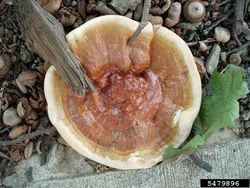Ganoderma (genus)
| Literature database |
|---|
| 120 articles sorted by: |
| • year (descending) |
| • research topics |
| • countries/regions |
| • host plants |
| • list of antagonists |

Author(s): Elizabeth Bush, Virginia Polytechnic Institute and State University
Source: IPM Images
Ganoderma (genus) P. Karst. 1881
The genus contains more than 300 species of wood decaying fungi. Many are saprobes, living on dead wood but several are important plant pathogens and infect the trunks of live conifers, hardwoods and monocotyledonous trees. Some species are also used for herbal medicines.
They develop large, shelf-like polypore (flat with pores) fruiting bodies attached to the trunks of trees, sometimes up to 60 cm in diameter. The genus is characterized by its double-walled basidiospores and the shape of the basidiocarp. Economically important species are Ganoderma boninense and Ganoderma lucidum.
The genus has been previously placed into a separate order, the Ganodermatales, but is now considered to be part of the Polyporales. For identifying the species the pore size and the morphology of the apical pilear cells are often useful, whereas the colour, shape and size of the basidiocarps are variable.
Type species: Ganoderma lucidum
For a taxonomic review see Richter et al., 2015, for other details see the respective page in Wikipedia.
Currently, the following species and groups have been entered into the system: